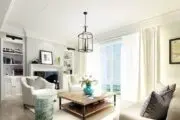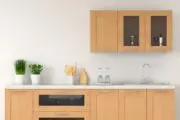The 1950s saw massive socio-economic growth and technological advancements in North America. The decade produced some pretty iconic home accessory designs, which have had a lasting effect on the decor you see today.
In fact, the mid-century modern movement has made a huge comeback recently, sparking a newfound lust for things like modular chairs, kitschy accent pieces and brightly colored, well, everything! Even if the date on your birth certificate is well past the second half of the 20th century, you can still be inspired by the quirky designs of the 1950s.
Check out these mid-century modern home staples for a blast into the past:
Brightly-colored blender

Colored kitchen appliances were all the rage in the 1950s. While white was originally the only available option for things like blenders and toasters, the middle of the 20th century saw an explosion of pastels like green, pink and blue as women started getting creative with their kitchen decor.
Atomic ball wall clock

This atomic ball wall clock screams mid-century modern design. George Nelson, a well-known clock designer during the 1950s, spearheaded the trend of quirky, artistic clocks. Along with the atomic ball clock, he also designed distinctive timepieces shaped like asterisks, the human eye, sunflowers and more.
Folksy floral serving dish

During the 1950s, families began eating in a less formal setting by combining the living and dining rooms and serving meals buffet-style. This brought on a strong trend of casserole and serving dishes, many of which came in creative, colorful patterns like this folksy floral one.
Art Deco table fan

The current obsession over all things retro has brought on a new appreciation for vintage fans like this one. Antique pieces are being nabbed up all over Etsy and thrift stores, and there’s even an official “fan” club called the Antique Fan Collectors Association.
Black and white checkerboard flooring

Checkerboard flooring was a ubiquitous feature in many 1950s kitchens. The introduction of inexpensive (read: boring!) linoleum flooring created a new desire for interesting shapes, colours and patterns. Black and white checkerboard added depth and appeal to an otherwise uninspiring material.
Pastel fridge

Feminine pastels didn’t stop at smaller-scale appliances. Many 1950s kitchens featured brightly coloured fridges and ovens in pink, green or blue, making for a much jauntier-looking room.
Model 500 telephone

During the 1950s, you’d most likely find Bell’s Model 500 telephone in the average North American household. This model featured an adjustable bell ringer, improved electronics and dial markings placed outside the finger holes to make them more legible. And no surprise here: several new colours were also introduced in the 1950s including lemon yellow, lime green and cherry red.
Kodak Pony 828 camera

The Kodak Pony 828 was in production from 1949 to 1959, so it’s basically the camera of the decade. Designed by Arthur H. Crapsey, the device could reach a shutter speed of 1/200 and had a 51mm lens with a maximum aperture of f/4.5 and a minimum of f/22.
Pastel transistor radio

The invention of the transistor in 1947 made portable radios a hot commodity in the 1950s. With its handy strap and bright, pastel hues, this retro Revival Radio from Roberts Radios perfectly mirrors the style of the mid-century gadgets.
Rattan furniture

Photo: Wicker Paradise/Flickr
The 1950s saw a revival of wicker and rattan in decorating trends. The renewed craze in the natural-looking furniture could be in part due to the work of Cecil Beaton, a photographer and decorator who shot celebrities and models like Marilyn Monroe, Jean Shrimpton and Katharine Hepburn.
“The Chair” by Hans Wegner

As one of the leaders of the Danish Modern movement, Hans Wegner had a massive influence on the decorative arts of the 1950s and 60s. Widely considered a “master chair-maker,” he created some of the most seminal seating pieces of the time like the peacock chair, the shell chair and “the chair,” (pictured above) which John F. Kennedy and Richard Nixon sat in during their first presidential debate.
Quirky animal figurines

Wartime frugality caused all the fun and color to drain out of people’s homes, leaving spartan gloom in its place. This sad lull in the decorative arts ended with the Second World War and “postwar pop pottery” emerged. People filled their homes with ceramic trinkets, sculptures and figurines, bringing back all the lighthearted fun and glory of tacky kitsch.
Brightly colored Tupperware

Believe it or not, optimism for the future and an increased interest in space technology went hand in hand with the Tupperware craze of the 1950s. People loved the sleek, modern design of the plastic containers and even went so far as to hold and attend “Tupperware parties,” where the host would sell select pieces to friends and neighbors.
Boxy televisions

The 1950s was a decade of massive growth and expansion for the television industry. In 1947, there were 100,000 TV sets in the US and just six years later that number had skyrocketed to 13 million. By 1950, color TV had come along and people had started using “TV lamps,” which were kitschy little trinkets — much like the lamb above — that sat atop the set to prevent eye damage.
Modular, fiberglass chairs

The mid-century modern movement was all about making furniture more accessible and affordable for the average person while promoting a cutting-edge, forward-thinking design aesthetic. Leading the pack was Charles and Ray Eames, the creators of many groundbreaking designs like the wire chair, the Eames Lounge Chair and the LCW, which was dubbed “the chair of the century” by Time magazine.






